Ji Zhao
General-Purpose Aerial Intelligent Agents Empowered by Large Language Models
Mar 11, 2025Abstract:The emergence of large language models (LLMs) opens new frontiers for unmanned aerial vehicle (UAVs), yet existing systems remain confined to predefined tasks due to hardware-software co-design challenges. This paper presents the first aerial intelligent agent capable of open-world task execution through tight integration of LLM-based reasoning and robotic autonomy. Our hardware-software co-designed system addresses two fundamental limitations: (1) Onboard LLM operation via an edge-optimized computing platform, achieving 5-6 tokens/sec inference for 14B-parameter models at 220W peak power; (2) A bidirectional cognitive architecture that synergizes slow deliberative planning (LLM task planning) with fast reactive control (state estimation, mapping, obstacle avoidance, and motion planning). Validated through preliminary results using our prototype, the system demonstrates reliable task planning and scene understanding in communication-constrained environments, such as sugarcane monitoring, power grid inspection, mine tunnel exploration, and biological observation applications. This work establishes a novel framework for embodied aerial artificial intelligence, bridging the gap between task planning and robotic autonomy in open environments.
Full-DoF Egomotion Estimation for Event Cameras Using Geometric Solvers
Mar 05, 2025Abstract:For event cameras, current sparse geometric solvers for egomotion estimation assume that the rotational displacements are known, such as those provided by an IMU. Thus, they can only recover the translational motion parameters. Recovering full-DoF motion parameters using a sparse geometric solver is a more challenging task, and has not yet been investigated. In this paper, we propose several solvers to estimate both rotational and translational velocities within a unified framework. Our method leverages event manifolds induced by line segments. The problem formulations are based on either an incidence relation for lines or a novel coplanarity relation for normal vectors. We demonstrate the possibility of recovering full-DoF egomotion parameters for both angular and linear velocities without requiring extra sensor measurements or motion priors. To achieve efficient optimization, we exploit the Adam framework with a first-order approximation of rotations for quick initialization. Experiments on both synthetic and real-world data demonstrate the effectiveness of our method. The code is available at https://github.com/jizhaox/relpose-event.
Adapter-Enhanced Semantic Prompting for Continual Learning
Dec 15, 2024



Abstract:Continual learning (CL) enables models to adapt to evolving data streams. A major challenge of CL is catastrophic forgetting, where new knowledge will overwrite previously acquired knowledge. Traditional methods usually retain the past data for replay or add additional branches in the model to learn new knowledge, which has high memory requirements. In this paper, we propose a novel lightweight CL framework, Adapter-Enhanced Semantic Prompting (AESP), which integrates prompt tuning and adapter techniques. Specifically, we design semantic-guided prompts to enhance the generalization ability of visual features and utilize adapters to efficiently fuse the semantic information, aiming to learn more adaptive features for the continual learning task. Furthermore, to choose the right task prompt for feature adaptation, we have developed a novel matching mechanism for prompt selection. Extensive experiments on three CL datasets demonstrate that our approach achieves favorable performance across multiple metrics, showing its potential for advancing CL.
Online Temporal Fusion for Vectorized Map Construction in Mapless Autonomous Driving
Sep 01, 2024Abstract:To reduce the reliance on high-definition (HD) maps, a growing trend in autonomous driving is leveraging on-board sensors to generate vectorized maps online. However, current methods are mostly constrained by processing only single-frame inputs, which hampers their robustness and effectiveness in complex scenarios. To overcome this problem, we propose an online map construction system that exploits the long-term temporal information to build a consistent vectorized map. First, the system efficiently fuses all historical road marking detections from an off-the-shelf network into a semantic voxel map, which is implemented using a hashing-based strategy to exploit the sparsity of road elements. Then reliable voxels are found by examining the fused information and incrementally clustered into an instance-level representation of road markings. Finally, the system incorporates domain knowledge to estimate the geometric and topological structures of roads, which can be directly consumed by the planning and control (PnC) module. Through experiments conducted in complicated urban environments, we have demonstrated that the output of our system is more consistent and accurate than the network output by a large margin and can be effectively used in a closed-loop autonomous driving system.
Enhancing Vectorized Map Perception with Historical Rasterized Maps
Sep 01, 2024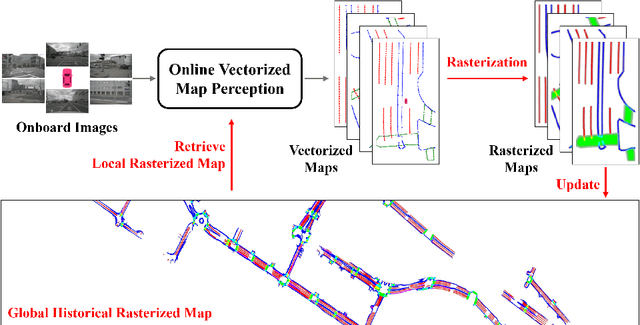
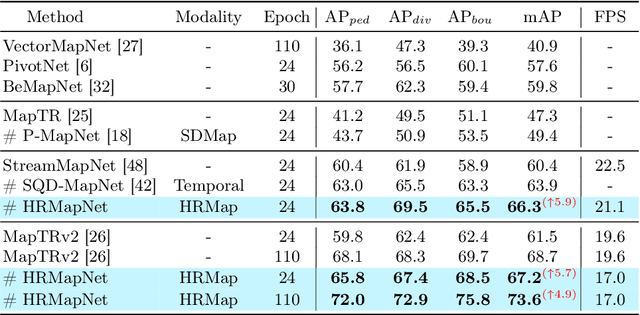
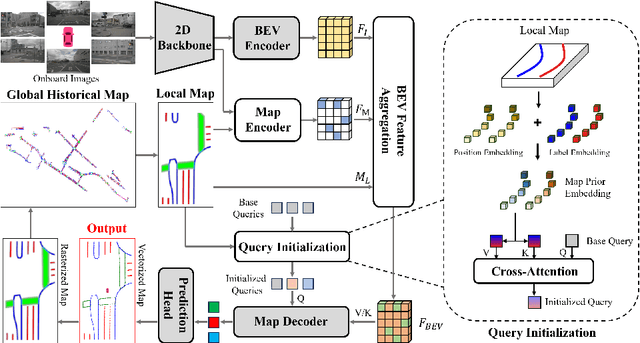

Abstract:In autonomous driving, there is growing interest in end-to-end online vectorized map perception in bird's-eye-view (BEV) space, with an expectation that it could replace traditional high-cost offline high-definition (HD) maps. However, the accuracy and robustness of these methods can be easily compromised in challenging conditions, such as occlusion or adverse weather, when relying only on onboard sensors. In this paper, we propose HRMapNet, leveraging a low-cost Historical Rasterized Map to enhance online vectorized map perception. The historical rasterized map can be easily constructed from past predicted vectorized results and provides valuable complementary information. To fully exploit a historical map, we propose two novel modules to enhance BEV features and map element queries. For BEV features, we employ a feature aggregation module to encode features from both onboard images and the historical map. For map element queries, we design a query initialization module to endow queries with priors from the historical map. The two modules contribute to leveraging map information in online perception. Our HRMapNet can be integrated with most online vectorized map perception methods. We integrate it in two state-of-the-art methods, significantly improving their performance on both the nuScenes and Argoverse 2 datasets. The source code is released at https://github.com/HXMap/HRMapNet.
Six-Point Method for Multi-Camera Systems with Reduced Solution Space
Feb 28, 2024



Abstract:Relative pose estimation using point correspondences (PC) is a widely used technique. A minimal configuration of six PCs is required for generalized cameras. In this paper, we present several minimal solvers that use six PCs to compute the 6DOF relative pose of a multi-camera system, including a minimal solver for the generalized camera and two minimal solvers for the practical configuration of two-camera rigs. The equation construction is based on the decoupling of rotation and translation. Rotation is represented by Cayley or quaternion parametrization, and translation can be eliminated by using the hidden variable technique. Ray bundle constraints are found and proven when a subset of PCs relate the same cameras across two views. This is the key to reducing the number of solutions and generating numerically stable solvers. Moreover, all configurations of six-point problems for multi-camera systems are enumerated. Extensive experiments demonstrate that our solvers are more accurate than the state-of-the-art six-point methods, while achieving better performance in efficiency.
Leveraging Enhanced Queries of Point Sets for Vectorized Map Construction
Feb 27, 2024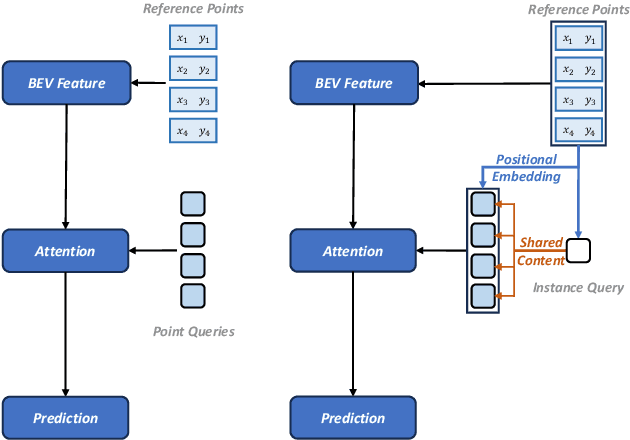
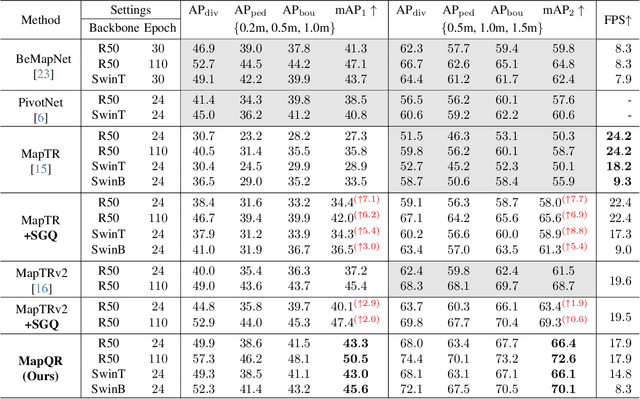

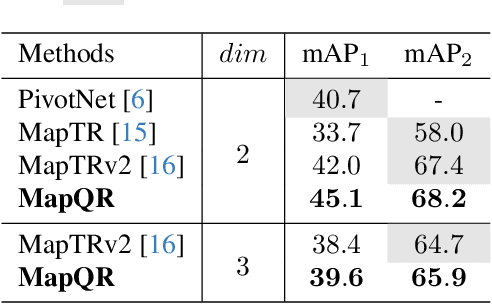
Abstract:In autonomous driving, the high-definition (HD) map plays a crucial role in localization and planning. Recently, several methods have facilitated end-to-end online map construction in DETR-like frameworks. However, little attention has been paid to the potential capabilities of exploring the query mechanism. This paper introduces MapQR, an end-to-end method with an emphasis on enhancing query capabilities for constructing online vectorized maps. Although the map construction is essentially a point set prediction task, MapQR utilizes instance queries rather than point queries. These instance queries are scattered for the prediction of point sets and subsequently gathered for the final matching. This query design, called the scatter-and-gather query, shares content information in the same map element and avoids possible inconsistency of content information in point queries. We further exploit prior information to enhance an instance query by adding positional information embedded from their reference points. Together with a simple and effective improvement of a BEV encoder, the proposed MapQR achieves the best mean average precision (mAP) and maintains good efficiency on both nuScenes and Argoverse 2. In addition, integrating our query design into other models can boost their performance significantly. The code will be available at https://github.com/HXMap/MapQR.
Affine Correspondences between Multi-Camera Systems for Relative Pose Estimation
Jun 22, 2023Abstract:We present a novel method to compute the relative pose of multi-camera systems using two affine correspondences (ACs). Existing solutions to the multi-camera relative pose estimation are either restricted to special cases of motion, have too high computational complexity, or require too many point correspondences (PCs). Thus, these solvers impede an efficient or accurate relative pose estimation when applying RANSAC as a robust estimator. This paper shows that the 6DOF relative pose estimation problem using ACs permits a feasible minimal solution, when exploiting the geometric constraints between ACs and multi-camera systems using a special parameterization. We present a problem formulation based on two ACs that encompass two common types of ACs across two views, i.e., inter-camera and intra-camera. Moreover, the framework for generating the minimal solvers can be extended to solve various relative pose estimation problems, e.g., 5DOF relative pose estimation with known rotation angle prior. Experiments on both virtual and real multi-camera systems prove that the proposed solvers are more efficient than the state-of-the-art algorithms, while resulting in a better relative pose accuracy. Source code is available at https://github.com/jizhaox/relpose-mcs-depth.
Transition Propagation Graph Neural Networks for Temporal Networks
Apr 15, 2023
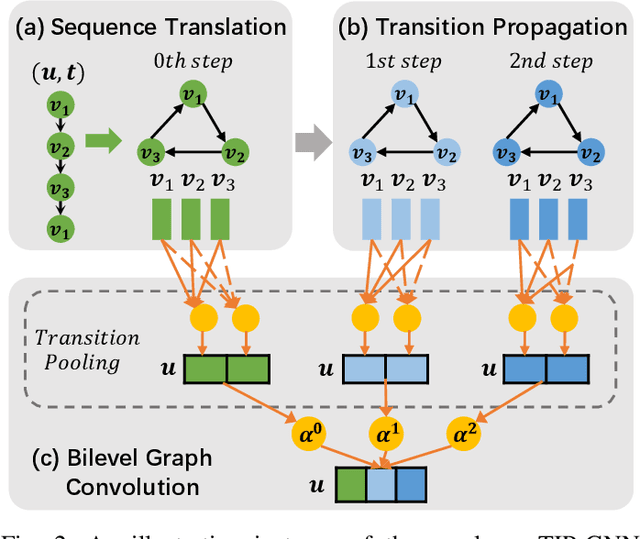

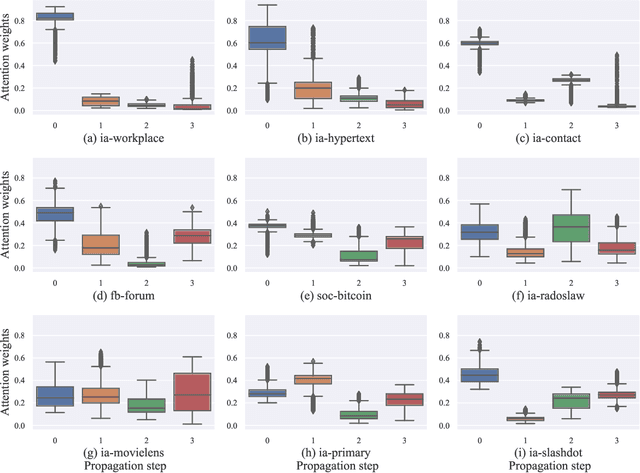
Abstract:Researchers of temporal networks (e.g., social networks and transaction networks) have been interested in mining dynamic patterns of nodes from their diverse interactions. Inspired by recently powerful graph mining methods like skip-gram models and Graph Neural Networks (GNNs), existing approaches focus on generating temporal node embeddings sequentially with nodes' sequential interactions. However, the sequential modeling of previous approaches cannot handle the transition structure between nodes' neighbors with limited memorization capacity. Detailedly, an effective method for the transition structures is required to both model nodes' personalized patterns adaptively and capture node dynamics accordingly. In this paper, we propose a method, namely Transition Propagation Graph Neural Networks (TIP-GNN), to tackle the challenges of encoding nodes' transition structures. The proposed TIP-GNN focuses on the bilevel graph structure in temporal networks: besides the explicit interaction graph, a node's sequential interactions can also be constructed as a transition graph. Based on the bilevel graph, TIP-GNN further encodes transition structures by multi-step transition propagation and distills information from neighborhoods by a bilevel graph convolution. Experimental results over various temporal networks reveal the efficiency of our TIP-GNN, with at most 7.2\% improvements of accuracy on temporal link prediction. Extensive ablation studies further verify the effectiveness and limitations of the transition propagation module. Our code is available at \url{https://github.com/doujiang-zheng/TIP-GNN}.
On Relative Pose Recovery for Multi-Camera Systems
Feb 24, 2021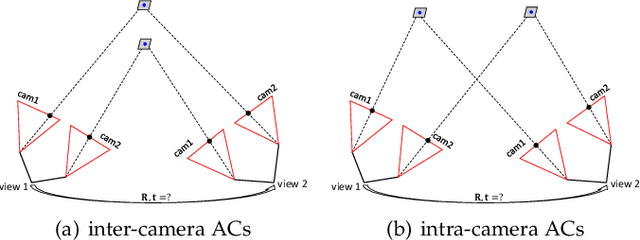

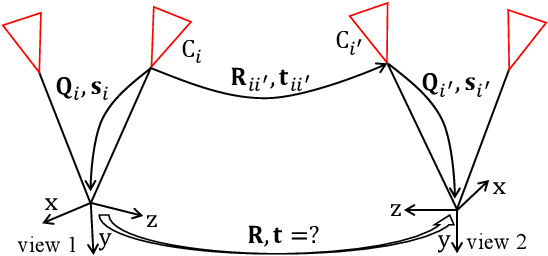

Abstract:The point correspondence (PC) and affine correspondence (AC) are widely used for relative pose estimation. An AC consists of a PC across two views and an affine transformation between the small patches around this PC. Previous work demonstrates that one AC generally provides three independent constraints for relative pose estimation. For multi-camera systems, there is still not any AC-based minimal solver for general relative pose estimation. To deal with this problem, we propose a complete solution to relative pose estimation from two ACs for multi-camera systems, consisting of a series of minimal solvers. The solver generation in our solution is based on Cayley or quaternion parameterization for rotation and hidden variable technique to eliminate translation. This solver generation method is also naturally applied to relative pose estimation from PCs, resulting in a new six-point method for multi-camera systems. A few extensions are made, including relative pose estimation with known rotation angle and/or with unknown focal lengths. Extensive experiments demonstrate that the proposed AC-based solvers and PC-based solvers are effective and efficient on synthetic and real-world datasets.
 Add to Chrome
Add to Chrome Add to Firefox
Add to Firefox Add to Edge
Add to Edge